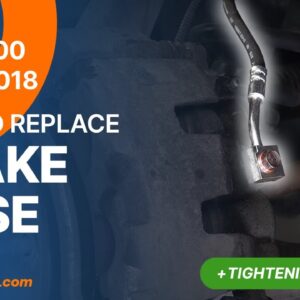Watch this video to learn how to replace the rear brake pads on a 2009-2018 Dodge RAM 1500.
Replacing Rear Brake Pads on a 2009-2018 Dodge RAM 1500: What You Need
Ready to perform this DIY replacement job? Remember that all the parts in this guide can be found on CarParts.com. Check out all the products that fit your vehicle right here.
Parts Checklist
- Brake pad set
- Brake cleaner
- Copper grease
Tightening Torques
- Slide pins:
- 2014 and earlier: 22 Ft-lbs
- 2015 and later: 24 Ft-lbs
Tools Checklist
Here’s the toolbox we recommend to repair your Dodge RAM 1500: HM85 85 Piece Ratchet and Socket Set
List of tools:
- Hydraulic jack
- Jack stands
- Wheel lug wrench
- Big flat head screwdriver
- Ratchet
- 13mm socket
- Cable or Hook
- Flat head screwdriver
- Wire brush
- Torque wrench
- Cloth
Step-by-Step Instructions
Step 1: Vehicle Preparation
- Turn off the vehicle’s ignition.
- Set the parking brake.
- Pull the hood release handle and open the hood.
- Open the brake fluid reservoir.
- Loosen the lug nuts on the rear wheels.
- Lift the rear of your vehicle.
- Place the vehicle on jack stands.
Step 2: Wheel Removal
- Take off the rear wheels to have full access.
- Place the wheels under the vehicle for safety.
Step 3: Caliper Removal
- Insert a flathead screwdriver into the oblong hole on the front of the brake caliper.
- Lift the caliper using the screwdriver as a lever to retract the piston.
- Use a ratchet and a 13mm socket to unscrew the slide pins.
- Remove the slide pins.
- Attach a piece of electrical cable or a hook to a strut spring coil.
- Remove the brake caliper and hang it on the hook.
Step 4: Brake Pad and Clip Removal
- Pry out the old brake pads with a flathead screwdriver.
- Use a flat head screwdriver to remove the anti-rattle clips.
- Brush the caliper mount around the pads to remove rust.
Step 5: Anti-Rattle Clips and Greasing
- Replace the anti-rattle clips with new ones.
- Place the new anti-rattle clips on the caliper mount.
- Coat the ends of the new pads with copper grease.
Step 6: New Pad Installation
Insert the new pads into the caliper mount by sliding them in.
Step 7: Caliper Reinstallation
- Put the brake caliper back in place.
- Screw in the slide pins by hand initially.
- Tighten the slide pins using a socket wrench and a 13mm socket.
- Finish tightening with a torque wrench.
Step 8: Cleaning and Final Steps
- Clean both sides of the disc with brake cleaner and a cloth to remove grease.
- Repeat the same process on the other side.
- Put the wheels back on your vehicle.
- Lower the car and block the wheels properly.
- Screw the brake fluid cap back on.
- Before driving, start the car, pump the brake pedal, and drive smoothly for the first 30 miles to avoid glazing the new pads.
Compatible Vehicles
The operation and tools displayed in the video should be available on the following vehicles:
- 2009 Dodge Ram 1500
- 2010 Dodge Ram 1500
- 2011 Ram 1500
- 2012 Ram 1500
- 2013 Ram 1500
- 2014 Ram 1500
- 2015 Ram 1500
- 2016 Ram 1500
- 2017 Ram 1500
- 2018 Ram 1500
Important Reminders
Once the operation is completed, you’ll need pump slowly on the brake pedal a few times until feeling a strong resistance from the pedal. The aim being to bring the brake pads closer to one other.
Don’t burn yourself on the pads if you’ve just gone for a drive as braking creates friction and long-lasting heat.
Drive smoothly and avoid sudden braking for the first 30 miles or so, to avoid glazing the new pads. What do we mean by “glazing new brake pads”? Brake pads are made of a material that needs to be run-in when new. If this procedure is not done properly, when braking too hard, the material overheats and hardens. Consequently, the brakes become less effective.
Disclaimer:
This video is for entertainment purposes only. CarParts.com, Inc. disclaims all damages including, but not limited to, actual, consequential, and/or punitive, for any liability, claim, or any other injury or cause related to or arising from any information or lack thereof posted in this video. No information contained in this video shall create any expressed or implied warranty or guarantee of any particular result. All mechanical car projects entail some risk. It is the sole responsibility of the viewer to assume this risk. If you are in doubt, please consult a licensed mechanic in your area.
Any information provided on this Website is for informational purposes only and is not intended to replace consultation with a professional mechanic. The accuracy and timeliness of the information may change from the time of publication.


















